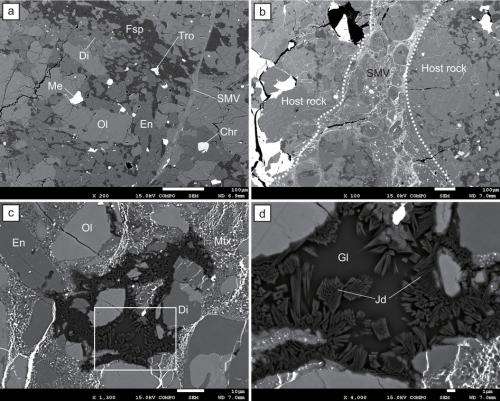May 23, 2014 report
Research shows collision created Chelyabinsk asteroid

(Phys.org) —On February 15 2013, an asteroid exploded about 30 kilometers above Chelyabinsk, Russia. The explosion, shared on video around the world, was the Earth's second largest recorded airburst. By analyzing fragments of the meteorite that fell to Earth, Shin Ozawa at Tohoku University in Sendai, Japan and colleagues determined that the asteroid formed when a parent asteroid collided with another asteroid and then broke apart. The research appears in Scientific Reports.
When an asteroid, 17 to 20 meters in diameter, burst over the south of Chelyabinsk city, in Russia's southern Ural region, it generated shockwaves that injured more than 1000 people and damaged many buildings. Unlike many other Near Earth Objects (NEOs), the Chelyabinsk asteroid had a well-recorded trajectory, and it left fragments on the Earth. This gave scientists a unique opportunity to study its formation.
Previous studies of the asteroid's fragments had shown they contain shock-melt veins, which form when heat and pressure from an impact cause materials in a section of an asteroid to melt. Eventually, shock-melt veins lose heat to cooler surrounding rock and solidify, forming glassy structures.
Ozawa's team examined the shock-melt veins in the Chelyabinsk fragments and found they contain the mineral jadeite, which forms under extremely high pressure. Some terrestrial rocks and meteorites contain jadeite. However, when the team examined the jadeite from the Chelyabinsk meteorite under an electron microscope, they found the mineral had a unique composition and structure that indicated it had crystallized very rapidly.
By calculating the rate at which the jadeite must have solidified, the team were able to determine that the asteroid must have formed when a parent asteroid collided with a second asteroid, which was at least 150 meters in diameter and moving at a relative speed of 0.4 to 1.5 kilometers per second. A previous study of the isotopes in the meteorite had shown that a collision could have occurred up to 290 million years ago. The jadeite would have formed as the result of this collision, as the mineral would not have survived a later impact.
Earlier calculations had shown that asteroids in the main asteroid belt have lifetimes of less than 10 million years. The researchers think the Chelyabinsk asteroid broke off from its parent after the collision and moved into an orbital resonance less than 10 million years ago. It then fell into an orbit crossing that of the Earth.
The research increases our understanding of how NEOs form and evolve. It shows that NEOs, which have the potential to strike the Earth, can survive much longer than previously believed.
More information: Jadeite in Chelyabinsk meteorite and the nature of an impact event on its parent body, Scientific Reports 4, Article number: 5033 DOI: 10.1038/srep05033
Abstract
The Chelyabinsk asteroid impact is the second largest asteroid airburst in our recorded history. To prepare for a potential threat from asteroid impacts, it is important to understand the nature and formational history of Near-Earth Objects (NEOs) like Chelyabinsk asteroid. In orbital evolution of an asteroid, collision with other asteroids is a key process. Here, we show the existence of a high-pressure mineral jadeite in shock-melt veins of Chelyabinsk meteorite. Based on the mineral assemblage and calculated solidification time of the shock-melt veins, the equilibrium shock pressure and its duration were estimated to be at least 3–12 GPa and longer than 70 ms, respectively. This suggests that an impactor larger than 0.15–0.19 km in diameter collided with the Chelyabinsk parent body at a speed of at least 0.4–1.5 km/s. This impact might have separated the Chelyabinsk asteroid from its parent body and delivered it to the Earth.
Journal information: Scientific Reports
© 2014 Phys.org




















